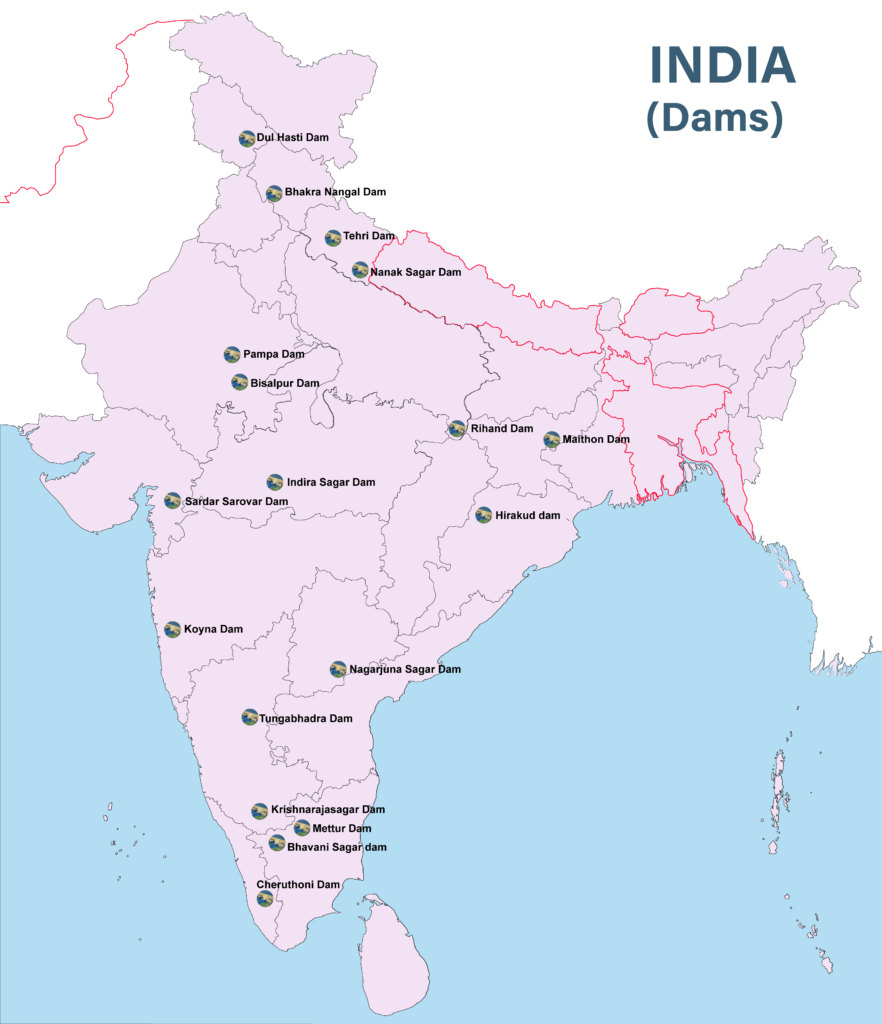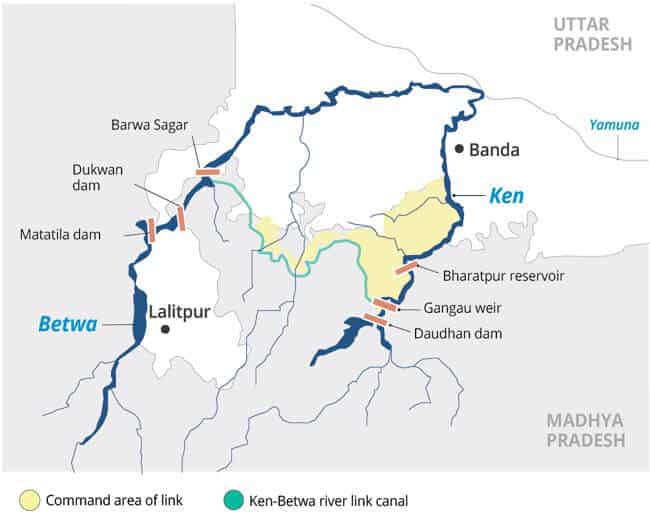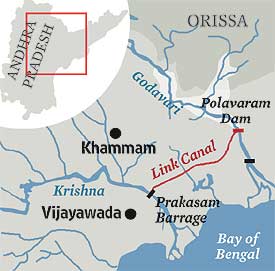Dam
A dam is a barrier that stops the flow of water and results in the creation of a reservoir. Dams are mainly built in order to produce electricity by using water. This form of electricity is known as hydroelectricity.
Reservoirs created by dams not only suppress floods but also provide water for activities such as irrigation, human consumption, industrial use, aquaculture, and navigability.
Based on the structure the types of dams are as mentioned below:
- Arch Dam: An arch dam is a concrete dam that is curved upstream in the plan. It is designed so that the hydrostatic pressure (force of the water against it) presses against the arch, causing the arch to straighten slightly and strengthening the structure as it pushes into its foundation or abutments. An arch dam is most suitable for narrow canyons or gorges with steep walls of stable rock to support the structure and stresses.
- Gravity Dam: Dams constructed from concrete or stone masonry are Gravity dams. They are designed to hold back water by using only the weight of the material and its resistance against the foundation to oppose the horizontal pressure of water pushing against it. These are designed in such a way that each section of the dam is stable and independent of other section.
- Arch-Gravity Dam: This dam has the characteristics of both an arch dam and a gravity dam. It is a dam that curves upstream in a narrowing curve that directs most of the water pressure against the canyon rock walls. The inward compression of the dam by the water reduces the lateral (horizontal) force acting on the dam.
- Barrages: A barrage is a type of low-head, diversion dam which consists of a number of large gates that can be opened or closed to control the amount of water passing through. This allows the structure to regulate and stabilize river water elevation upstream for use in irrigation and other systems.
- Embankment Dams: An embankment dam is a large artificial dam. It is typically created by the placement and compaction of a complex semi-plastic mound of various compositions of soil, sand, clay, or rock. It has a semi-pervious waterproof natural covering for its surface and a dense, impervious core.
- Rock-Fills Dams: Rock-fill dams are embankments of compacted free-draining granular earth with an impervious zone. The earth utilized often contains a high percentage of large particles, hence the term “rock-fill”.
- Concrete-face rock-fill dams: A concrete-face rock-fill dam (CFRD) is a rock-fill dam with concrete slabs on its upstream face. This design provides the concrete slab as an impervious wall to prevent leakage and also a structure without concern for uplift pressure.
- Earth-fill dams: Earth-fill dams, also called earthen dams, rolled-earth dams or simply earth dams, are constructed as a simple embankment of well-compacted earth. A homogeneous rolled-earth dam is entirely constructed of one type of material but may contain a drain layer to collect seep water.
Highlights on some important Dams in India:
| Highest Dam in India | Tehri Dam(Uttarakhand) | River: Bhagirathi River |
| Longest Dam in India | Hirakud Dam (Odisha) | River: Mahanadi |
| Oldest Dam in India | Kallanai Dam(Tamil Nadu) | River: Kaveri |
Significance of Dams
- Source of Clean Energy: Dams are the sources of clean power. Many countries have embraced dams as a way to reduce reliance on expensive fossil fuels.
- Irrigation: Dams and waterways store and provide water for irrigation so farmers can use the water for growing crops.
- In areas where water and rain are not abundant (like the desert), irrigation canals from rivers and dams are used to carry water.
- Prevent Flooding: Dams, if planned well, help in preventing floods. They catch extra water so that it doesn’t run wild downstream.
- Source of Drinking Water: Since the water stored in dams is freshwater, it can also be used as drinking water.
Dams and Destruction
While dams can benefit society in many ways, they are also one of the biggest menaces to river ecology, wildlife, the aquatic habitat of fish, and ultimately humans.
- Affect the Aquatic Life: Dams prevent fish migration and limit their ability to access spawning habitat, seek out food resources, and escape predation.
- Aquatic organisms depend on steady flows to guide them while stagnant reservoir pools disorient migrating fish and can significantly increase the duration of their migration.
- Dams block Rivers: Dams and reservoirs are physical barriers to the flow of water bodies as they fragment them and reservoirs, which impact their seasonal flow.
- They also change the way rivers function and trap sediment, burying rock riverbeds where fish spawn.
- Gravel, logs, and other important food and habitat features can also become trapped behind dams. This negatively affects the creation and maintenance of more complex habitats downstream.
- A Hazardous Infrastructure: Large dams, even if structurally sound, are regarded as “high hazard” infrastructure because of the potential for a massive loss of human lives, livelihoods, and destruction in the event of failure.
- In the most recent Uttarakhand flash floods, experts say the incident was induced by the effect of global warming on melting glaciers but the effect was worsened by the construction of infrastructure (Hydroelectric Power Projects, HEPs).
- HEPs which use large-scale blasting, tree felling, and tunneling, most certainly added to the proportion of the impact. They became a force multiplier in the destruction.
- The construction was against the recommendation of the Chopra Committee which submitted a detailed report warning that a glacial retreat in the state of Uttarakhand, coupled with structures built for hydroelectricity generation and dams, could lead to large-scale disasters downstream.
- In the most recent Uttarakhand flash floods, experts say the incident was induced by the effect of global warming on melting glaciers but the effect was worsened by the construction of infrastructure (Hydroelectric Power Projects, HEPs).
- Reservoir Induced Seismicity: There is a strong relationship between the earthquakes and the loading and unloading of water from the dam. The Koyna and Warna region is possibly the best example of reservoir-induced seismicity (RIS).
- The Koyna and Warna reservoirs are responsible for the earthquakes in the south Maharashtra region which has experienced many earthquakes in five decades.
- This series of earthquakes have occurred post the construction of dams in the region.
- The Koyna and Warna reservoirs are responsible for the earthquakes in the south Maharashtra region which has experienced many earthquakes in five decades.
- Displacement of People: The land submergence and large-scale displacement of people due to the construction of large dams is one prevailing issue which is often overlooked by the authorities.
- Construction of dams such as Hirakud, Bhakra Nangal, and Tehri had displaced a number of families many of which were not rehabilitated at all.
- Even after rehabilitation, lack of livelihood opportunities and poor living conditions are still observed.
- Sardar Sarovar Dam, the largest structure on the Narmada river, has displaced over 3 lakh families.
- Construction of dams such as Hirakud, Bhakra Nangal, and Tehri had displaced a number of families many of which were not rehabilitated at all.
- Older Dams are Greater Hazard: Older dams pose greater safety risks, cost higher in terms of maintenance, and have declining functionality due to sedimentation, stated
- Globally, over 1,115 large dams will be about 50 years old by 2025.
- China, the US, and India top the list of countries with a significant number of large dams.
- China alone hosts 40% of the world’s large dams (numbering 23,841), their average age being 45 years.
- India has 4,407 large dams of which more than 1,000 would be 50 years or older by 2025, a new study has shown.
- India has 209 dams that are over 100-year-old, built when design practices and safety were far below current norms.
- Greenhouse Gas Emissions: Particularly in tropical regions, hydropower reservoirs emit significant amounts of greenhouse gases.
- The water gathers behind the dam, creates an unnatural, stagnant lake that often kills off a lot of the existing ecosystem. Bacteria in the water decompose these plants and generate carbon dioxide and methane (potent greenhouse gas).
- Methane from reservoirs accounts for more than 4% of all human-caused climate change comparable to the climate impact of the aviation sector.
- In some cases, hydropower projects are producing higher emissions than coal-fired power generating the same amount of electricity plants.

| Major Dams in India | State | River |
| Bhavani Sagar dam | Tamil Nadu | Bhavani |
| Tungabhadra Dam | Karnataka | Tungabhadra |
| Rihand Dam | Uttar Pradesh | Rihand |
| Maithon Dam | Jharkhand | Barakar |
| Koyna Dam | Maharashtra | Koyna |
| Bisalpur Dam | Rajasthan | Banas |
| Mettur Dam | Tamil Nadu | Kaveri |
| Krishnarajasagar Dam | Karnataka | Kaveri |
| Indira Sagar Dam | Madhya Pradesh | Narmada |
| Cheruthoni Dam | Kerala | Cheruthoni |
| Sardar Sarovar Dam | Gujarat | Narmada |
| Nagarjuna Sagar Dam | Telangana | Krishna |
| Hirakud dam | Odisha | Mahanadi |
| Bhakra Nangal Dam | Punjab-Himachal Pradesh Border | Sutlej |
| Thein Dam project | Punjab | Ravi |
| Beas Project (Sharda Sahayak Project) | A joint venture of Punjab, Haryana, and Rajasthan, Uttar Pradesh | Beas |
| Tehri Dam | Uttarakhand | Bhagirathi |
| Dulhasti project | Jammu and Kashmir | Chenab |
| Salal project | Jammu and Kashmir | Chenab |
| Banasagar project | M.P., Bihar, and U.P. | Son |
| Rihand Scheme Reservoir | Uttar Pradesh | Rihand |
| Damodar valley multipurpose project four dams: Tilaiya and Maithon (on the Barakar River), Konar (Konar River), and Panchet (Damodar River). | West Bengal (also shared by Jharkhand). | Damodar |
| Mayurakshi project | West Bengal | Mayurakshi |
| Poochampad Project | Andhra Pradesh | Godavari |
| Jayakwadi Project | Maharashtra | Godavari |
| Upper Krishna Project | Karnataka | Krishna |
| Ghatprabha project | Andhra Pradesh and Karnataka. | Ghatprabha (A tributary of Krishna) |
| Malprabha project | Karnataka | Malprabha |
| Bima project | Maharashtra | Bhima |
| Shivasamudram Scheme | Karnataka | On Cauvery Falls |
| Kundah project | Tamil Nadu | Kundah |
| Sharavati Project | Karnataka | Sharavati (near Jog falls) |
| Chambal project(Gandhi Sagar Dam (M.P.), Rana Pratap Sagar and Jawahar Sagar Dam or Kota Dam. | Rajasthan, Madhya Pradesh | Chambal |
| Kakrapara Project | Gujarat | Tapi |
| Ukai Project | Gujarat | Tapi |
| Tawa project | Madhya Pradesh | Tawa (A tributary of Narmada. |
| Mahi Project (Jamnalal Bajaj Sagar) | Gujarat | Mahi |
| Matatila Project | Uttar Pradesh, Madhya Pradesh | Betwa |
| Dams in News | State | River |
|---|---|---|
| Edamalayar Dam | Kerala | Idamalayar (a tributary of the Periyar River) |
| Idukki dam | Kerala | Periyar River |
| Cheruthony Dam | Kerala | Periyar River |
| Peppara Dam | Kerala | Karamana River |
| Kakki dams | Kerala | Kaki River (a tributary of the Pampa) |
| Anathode dams | Kerala | Anathode river (a tributary of Pamba River) |
| Sholayar Dam | Kerala | Chalakkudi River |
| Kallarkutty Dam | Kerala | Muthirapuzha river |
| Kundala Dam | Kerala | Muthirapuzha River (a tributary of Periyar River) |
| Pampa Dam | Kerala | Pampa river |
| Malankara Dam | Kerala | Thodupuzha river |
| Nanak Sagar Dam | Uttarakhand | Deoha river |
Mullaperiyar Dam
- The Mullaperiyar Dam, a gravity dam in Kerala is a 126-year-old barrage that has dangerously outlived its 50 years of life.
- The dam is located in the Western Ghats, adjacent to the Periyar wildlife sanctuary, built during the British colonial period.
- A gravity dam is one that is designed to withstand water by its own weight and resistance.
- The weight and width of the base prevent the dam from overturning when subjected to the force of impounded water.
- The dam is considered hazardous, not only because of its age but also for its location in an acknowledged seismic zone (zone-III).
- The dam is located in the Western Ghats, adjacent to the Periyar wildlife sanctuary, built during the British colonial period.
- Decommission of the Dam: The government of Kerala carried out hydrological review studies between 2006 and 2011 that concluded that the Mullaperiyar Dam is unsafe for passing the estimated probable maximum flood limit.
- Both IIT-Roorkee and IIT-Delhi have deemed the dam to be fit to be decommissioned.
- However, decommissioning Mullaperiyar is strongly opposed by Tamil Nadu state, which inherited a lease agreement between the former princely state of Travancore (now Kerala) and the British government.
- The lease allows Tamil Nadu to operate the dam and divert 640 million cubic metres of water annually for irrigation and power generation through a tunnel bored into the Western Ghat mountains that form a wall between the two states.
- Both IIT-Roorkee and IIT-Delhi have deemed the dam to be fit to be decommissioned.
Daudhan Dam
- A 77 metre high dam, namely Daudhan is proposed across river Ken, about 2.5 km upstream of the existing Gangau Weir on Ken river.
- Construction of the Daudhan dam will result into the submergence of 10% of the critical tiger habitat of MP’s Panna Tiger Reserve that will adversely affect the tiger conservation efforts.
- Submergence by Daudhan and Makodia reservoirs will result into the displacement of 20,000 people of the Bundelkhand region and will give rise to rehabilitation issues.
- Ken Betwa Link Project: two phases
- Under Phase-I, one of the components — Daudhan dam complex and its appurtenances like Low-Level Tunnel, High-Level Tunnel, Ken-Betwa link canal, and Powerhouses — will be completed.
- While in Phase-II, three components — Lower Orr dam, Bina complex project, and Kotha barrage — will be constructed.

Polavaram Irrigation Project
- Polavaram Project is located in Andhra Pradesh on the river Godavari, near Polavaram village.
- It is a multi-purpose irrigation project as the project once completed will provide Irrigation benefits and will generate Hydroelectric Power. In addition, this project will also supply drinking water.
- It will facilitate an inter-basin transfer to the Krishna river basin through its Right canal.
- Its reservoir spreads in parts of Chhattisgarh and Orissa States also.
- It will also provide indirect benefits such as the development of Pisciculture (breeding and rearing of fish), tourism, and urbanization.
- The Project has been accorded national project status by the union government in 2014 (under Section-90 of Andhra Pradesh Reorganization Act, 2014).
- Kolam tribes, Kondareddis tribes
- Six other projects in Andhra Pradesh
- Vamsadhara-Phase 2 [River Vamsadhara or River Banshadhara]
- Vamsadhara-Nagavali link [Vamsadhara and Nagavali rivers]
- Owk tunnel-2
- Velugonda-Phase 1
- Nellore
- Sangam barrages


This post is Very useful for everyone……
🍺
Thank u so much for this detailed coverage !!
ನಮಗೆ pdf ಬೇಕು
Please check out this page
https://store.lotusarise.com/
Sir i purchased ur geography india map module. Does it have latest places in news??
No, You will have to cover the latest places in news from any current affairs magazine.
All these content are very useful for all govt. exam like PCS, UPSC and SSC. Thank u sir🙏🙏
Thank you Sir 🙏🙏
I have a wish having hardcopy of these notes